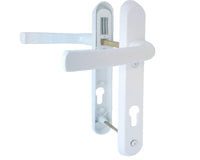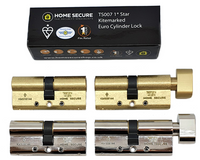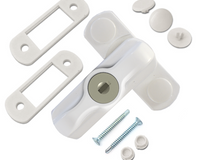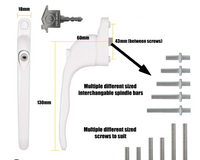If you’ve ever noticed rainwater pooling inside your doorway or felt a chilly draught creeping in, your door may be missing an important layer of protection. Water ingress doesn’t just cause discomfort — over time it can lead to warped frames, damp patches, and higher heating bills. The good news is there’s a simple fix: a door weather bar (also known as a rain deflector or drip board).
🌧 Why Doors Leak in Wet Weather
Even modern uPVC and composite doors can suffer from leaks and draughts if they don’t have proper protection at the base. Common causes include:
-
Gaps at the door threshold where the frame meets the ground
-
Heavy rainfall running directly down the door surface
-
Missing or worn-out weather bars or seals
-
Poor drainage around the door area
When water isn’t diverted away, it can seep inside, damaging flooring, skirting boards, and even the door itself.
🔒 The Role of a Door Weather Bar
A door weather bar is a slim strip fitted horizontally across the bottom of the door. Its job is simple but effective: to deflect rainwater away from the threshold. By preventing water ingress and reducing draughts, it helps keep your home warmer, drier, and more energy efficient.
Unlike bulky draught excluders, a weather bar provides a neat, built-in solution that blends seamlessly with your door.
🛠 The Easiest Fix: uPVC Door Weather Bar – Rain Water Deflector
At Home Secure Shop, we recommend the uPVC Door Weather Bar – Rain Water Deflector / Drip Board.
Here’s why it’s one of the easiest upgrades you can make:
-
Peel-and-stick fitting – comes with high-bond double-sided tape, so no screws or drilling are needed.
-
Quick DIY install – simply clean the surface, cut to size, peel, and stick in place.
-
Extra protection – apply a thin bead of silicone along the top edge after fitting for even greater durability.
-
All-weather performance – keeps rain and draughts out while improving insulation.
-
Universal compatibility – suitable for uPVC, composite, timber, and aluminium external doors.
This small, affordable upgrade makes a big difference — protecting your home from water damage while reducing heat loss.

✅ How to Fit Your New Weather Bar in 5 Steps
-
Clean the door surface thoroughly and let it dry.
-
Measure and cut the weather bar to the correct width.
-
Dry-fit in position 10–15 mm above the threshold.
-
Peel and stick the backing tape firmly along the full length.
-
Seal the top edge with a bead of exterior-grade silicone.
And that’s it — your door now has a built-in rainwater defence system!

Rainwater leaks don’t just happen because of worn seals or gaps — sometimes, they’re the result of poor drainage around your entrance. The UK Government’s guidance on Sustainable Drainage Systems (SuDS) explains how proper surface water management helps prevent water from pooling or seeping toward your property. Read the official SuDS guidance here. By combining quality door seals and weather bars with good external drainage and ground fall away from the threshold, you can stop leaks before they start — keeping your entryway dry, safe, and protected all year round.
🌟 Final Thoughts
If you’re struggling with rainwater leaking under your front or patio door, a weather bar is the quickest and most cost-effective solution. The uPVC Door Weather Bar – Rain Water Deflector / Drip Board offers easy DIY installation, lasting protection, and a neat finish.
👉 Shop the uPVC Door Weather Bar today and keep your home warmer, drier, and more energy efficient all year round.
❓ Frequently Asked Questions
Q: What is a door weather bar?
A: A weather bar (also called a rain deflector or drip board) is a slim strip fitted to the bottom of a door to channel rainwater away from the threshold, helping prevent leaks and draughts.
Q: Do I need screws to fit a uPVC door weather bar?
A: No. The Home Secure™ uPVC Door Weather Bar uses double-sided high-bond tape for quick fitting — no screws or drilling required.
Q: Should I use silicone with a weather bar?
A: Yes. For the best long-term performance, apply a thin bead of exterior-grade silicone along the top edge after installation to seal and improve durability.
Q: Will a weather bar work on composite or timber doors?
A: Absolutely. While designed for uPVC doors, weather bars are also suitable for composite, timber, and aluminium doors.
Q: Can fitting a weather bar help with draughts?
A: Yes. By sealing the bottom edge of the door and deflecting rain, weather bars also reduce draughts, helping to improve energy efficiency.

📚 Featured Collections in this Article
Door Weather Seals & Gaskets
Stop rain and draughts at the source with compression and brush seals for uPVC, composite, and timber doors—available in multiple profiles, kerf/slot types, and colours for a clean, long-lasting fit.

Rain Deflectors & Weather Bars
Surface-mounted aluminium or uPVC deflectors that push water away from the bottom of the door—ideal when wind-driven rain pools at the threshold or blows under the leaf.












